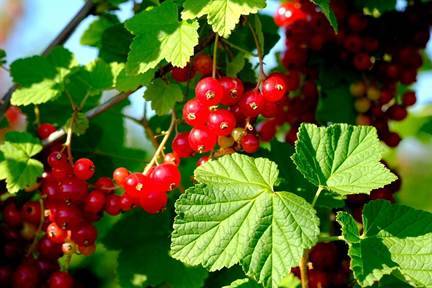By Jeanette Stehr-Green
For the Sequim Gazette
Last week, we covered four of the more popular small fruits grown in home gardens: strawberries, blueberries, raspberries and blackberries.
Some gardeners, however, are attracted to the less well known small fruits because of particular fruit characteristics or the novelty of the plants.
Currants, gooseberries, jostaberries
Currants and gooseberries are closely related shrubs in the genus Ribes. Although extremely popular in Europe, they are less well known in the United States due to a federal ban (that ended in the mid-1960s) on growing them.
This lack of familiarity is unfortunate because both currants and gooseberries grow well in cooler temperatures and tolerate partial shade and clay soils, making them easy to grow in most gardens.
Currants are erect, thornless shrubs that grow 3-5 feet in height. Depending on the variety, they produce clusters of red, white or black berries that make great jelly, jam and preserves. When very ripe, red and white currants can be eaten fresh. Black currants, which have a high vitamin C content and a strong resinous flavor, are rarely eaten out of hand.
Gooseberries are fast growing shrubs that can reach 5-7 feet in height; most varieties have large, formidable thorns. Their translucent yellow-green or dusky purple red fruit can be as small as a grape to as large as a small plum, depending on the variety. The fruit tends to be sour and best used in pies and other cooked desserts; “dessert” varieties are sweeter and can be eaten (and enjoyed) fresh.
Landscape uses: Currants and gooseberries are attractive shrubs that fit well into the home landscape. Their light green foliage turns bronze to red in the fall and the clusters of berries, especially those of red currants, are striking. Currants and gooseberries make interesting focal points in the ornamental landscape or deciduous hedges when planted more closely together. The size and natural growth habit of currant bushes makes them an excellent choice for containers, although a relatively large container (at least 20 inches in diameter) will be needed.
Jostaberries are hybrids of black currants and gooseberries. Its bush is thornless and its deep purple to black fruit is sweeter than a gooseberry but high in vitamin C like a black currant. Unfortunately, jostaberries have not performed particularly well in North America.
Honeyberries
Honeyberries (also known as Haskap berries) look like elongated blueberries but are actually close relatives of honeysuckle. Honeyberries are native to Siberia and northern Japan and extremely cold-hardy. They provide the earliest fruit of the season, producing berries a couple of weeks before strawberries.
Honeyberries are relatively large bushes reaching 6 feet in height at maturity. Unlike the other small fruits, honeyberries need a cross-pollinator (a different variety planted close by) for fruit production.
Although honeyberries prefer a slightly acidic soil, they are adapted to a pH range of about 5-8. As such, they are an alternative to acid-loving blueberries in alkaline soils.
Honeyberry fruit is tart but difficult to characterize; some say it tastes like a blueberry but less sweet. Honeyberries make good jams and jellies, and can substitute for blueberries in most recipes.
Landscape uses: Because of the plant’s ultimate size, honeyberries are well adapted to use as a hedge or a focal point in the landscape.
Aronia
Aronia, a member of the apple family, is a popular shrub in Europe. Although native to the east coast; aronia has only recently been cultivated in the United States due to interest in its potential health benefits.
Aronia is a fairly large shrub, standing 4-8 feet high at maturity. Aronia has a tendency to sucker (that is send up new sprouts from its spreading root system). The plants are tolerant of salt spray, drought, soil compaction and poorly drained soils.
Aronia produces small, glossy blue-black fruits that hang down in clusters. Due to a high tannin content, the fruits are astringent (resulting in the common name “black chokeberry”). Aronia fruit are used almost exclusively for juice which is mixed with juice from other fruits and berries.
Landscape uses: Aronia bushes provide year round interest — deep green foliage and pretty white flowers in spring and deep purple berries nestled into red-orange leaves in fall. Because of suckering, aronia can form a dense thicket that is good for erosion control and windbreaks. Because ripe fruit will hang on the plant if not picked, it is an excellent food source in the late-season for birds.
Also …
Here are a few final words of advice when growing small fruits in the home garden.
Select varieties that grow well in our climate. Those that bloom too early can be damaged by late frosts and those that ripen too late or require a long growing period might never reach maturity.
Prepare the planting site well before planting to remove perennial weeds. Small fruits have relatively superficial roots and removal of weeds after planting can damage root systems.
For best results plant small fruits in a spot that receives full sun. Some small fruits will produce in dappled shade (blackberries, currants and gooseberries) but 6 or more hours of direct sun is needed for flavorful and sweet fruit.
Plan to irrigate during dry periods. Most small fruits need 1-2 inches of water each week, especially as the fruit is increasing in size and in late summer when fruit buds are being formed for the next year. Drip irrigation and soaker hoses are efficient forms of watering that keep plant foliage dry; organic mulches around the plants will also help conserve soil moisture.
Protect your harvest from wildlife. Birds, deer, and other animals love small fruits as much as we do. Scare tactics, such as mylar strips and whirligigs, work only for a limited amount of time; deer proof fences and bird netting will be needed.
Jeanette Stehr-Green is a WSU-certified Clallam County Master Gardener.


